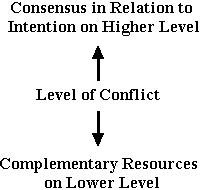
Resolving Conflicts with NLP
Conflict is defined as “a state of disharmony between incompatible or antithetical persons, ideas, or interests.” Psychologically, conflict is a mental struggle, sometimes unconscious, resulting when different representations of the world are held in opposition or exclusivity. Conflicts can occur either between parts of ourselves internally (inner conflict) or externally with others (interpersonal conflict).
Internally, conflicts occur between different parts of human experience and at many levels. Conflicts may occur about behaviors, for example. A person may want to watch a certain television program on one hand, but on the other hand go outside and get exercise. Conflicts may also occur between various capabilities, between creativity and protection. A person may have conflicting beliefs or values. An individual may believe it is very appropriate to learn mathematics, on one hand, but not believe that it is possible for him or her to learn. This will lead to a struggle with respect to learning math. Identity level conflicts often occur with respect to roles. A person may experience struggles between their duties as a parent on one side, and as a professional on the other.
Interpersonally, different individual’s maps of reality are sometimes so diverse that “bumps” arise when they attempt to communicate or interact together. Basic assumptions, beliefs, values and presuppositions about the world become clustered together to create different models of reality. When these models or maps don’t contain mechanisms for responding creatively to “bumps” with other maps, energy is released in the form of disagreement, dispute, fighting, or other forms of conflict. Negotiation, mediation and arbitration are all various forms of managing interpersonal conflicts.
Conflicting ‘Parts’
Sometimes, people experience being “incongruent,” in an “inner conflict,” “of two minds,” or “at odds” with themselves. These issues do not relate so much to external pressures, but rather to the deeper structures within the person himself or herselfÑto conflicts between different ‘parts’ of one’s own mental system. In other words, these issues relate to conflicts between oneself and oneself. Freud believed such internal struggles were ultimately at the root of many psychological problems. As he maintained
“One side of the personality stands for certain wishes, while another part struggles against them and fends them off. There is no neurosis without such a conflict.”
According to Freud
Conflict is produced by frustration…in order to become pathogenic, external frustration must be supplemented by internal frustration…external frustration removes one possibility of satisfaction, internal frustration tries to exclude another possibility, and it is this second possibility which becomes the debate ground of the conflict.
In a typical situation, if we are prevented from reaching a goal due to an external impasse, we maintain our focus on the outcome, inhibit any “antithetical ideas” and continue to attempt other avenues or strategies in order to attain the goal.
If there is an internal conflict, however, the “debate ground” shifts inward, and a battle begins between the two parts of one’s self. As Freud points out, the external frustration is supplemented by internal frustration. It is as if the person is “caught between a rock and a hard place.” And when the fight is between two parts of one’s self, one can never “win.” As Freud put it
This conflict is not resolved by helping one side to win a victory over the other…one side in either event will remain unsatisfied.
Attempting to solve this type of conflict by suppressing one side, as one would do with typical “antithetical ideas,” creates a ‘double bind’ in which you are “damned if you do and damned if you don’t.” It is as if the struggle is between two conflicting intentions rather than between an intention and the uncertainty as to whether it will be achieved. This makes the situation different than what is addressed by reframing, in that the core issue is not understanding the intention of the part to which one has not been listening. In that case, the focus is on a particular problematic behavior. The resolution involves finding the intention behind the behavior and generating alternative choices in order to reach the intention. In the case of conflict, however, it is the confrontation of antagonistic intentions that is at issue. Because the parts are at cross purposes, no alternatives can be produced which satisfy both intentions directly.
Furthermore, because the internal conflict is not grounded in external events or results, it cannot be resolved by feedback from some external source. In fact, in such a situation, anything can become another stimulus (or excuse) for a fight. Even the simplest decisions lead to a struggle – a struggle which is never resolved because it is not really about the content of the decision but about the deeper structure beneath it.
The constant stress coming from the conflict and frustration may lead to other symptoms, including physical symptoms. These symptoms also become a “debate ground” for the conflicting parts. Since systems attempt to reach balance or homeostasis, however, certain symptoms may actually provide a potential point of “compromise” between the conflicting parts. As Freud claimed
The two powers which have entered into opposition meet together again in the symptom and become reconciled by means of the compromise contained in symptom-formation. That is why the symptom is capable of such resistance; it is sustained from both sides. . . It is a battle between two forces of which one has succeeded in coming to the level of the preconscious and conscious part of the mind, while the other has been confined on the unconscious level. That is why the conflict can never have a final outcome one way or the other…An effective decision can be reached only when they confront each other on the same ground. And, in my opinion, to accomplish this is the sole task of the treatment.
Conflict Integration
Conflict Integration refers to the NLP procedure by which contradictory or incompatible responses, “parts” or cognitive processes are sorted and resolved. Conflict Integration is one of the core NLP interventions and is essential to the resolution of many mental, physical and interpersonal problems.
According to Grinder and Bandler (The Structure of Magic Volume II, 1976, p. 45), the basic steps of conflict integration involve
- Identifying the client’s incongruencies by noticing contradictions within verbal and non-verbal messages.
- Sorting the client’s incongruencies into polarities via spatial sorting, fantasy (symbols), representational systems, role playing, or Satir Categories (Blaming, Placating or Super-Reasonable).
- Integrating the client’s incongruencies by first making contact between the polarities, and then achieving a meta position from which to bring the polarities together in a new way.
A key component to the process of Conflict Integration that has been added since the writing of The Structure of Magic Volume II is the identification and recognition of the positive intentions of both of the parts involved.
A large part of the NLP conflict integration process involves sorting experiences into their appropriate levels in order to avoid unnecessary confusion and trouble. A typical approach to conflict resolution in NLP is to first “chunk up” one level above the conflict to find consensus with respect to “higher level” positive intentions. A second step involves “chunking down” one level below the level at which the conflict is taking place. At this “lower level” it is possible to find “complementary” resources related to the parts of the system which are seemingly in conflict.

Solving a Problem Through a Different Level of Thinking
Than is Creating the Problem
NLP Provides many skills and tools for addressing and resolving both internal and interpersonal conflicts. These include techniques of Reframing, Conflict Integration, shifting Perceptual Positions, and many fundamental communication skills such as the Meta Model, Calibration and non-verbal communication methods.
The NLP Conflict Integration process was initially developed to address internal conflicts within an individual, and has also become the basis for the negotiations model in NLP. The following is a general overview of the basic NLP approach to addressing conflicts.
- Clearly identify the key issues involved in the conflict. These issues will be expressed as either opposites or polarities. Determine at which logical level the conflict is most focused.
e.g., investing or spending money versus saving money = a behavior level conflict - Establish an unbiased ‘meta-position’ that is clearly distinct from either of the parties in conflict.
- Find the positive intention and purpose behind the issues of each party. The positive intention will necessarily be at a higher level than the issues creating the conflict. (“You cannot solve a problem at the same level of thinking that is creating the problem.”) Positive intentions will typically not be opposites or polarities. More often they are complementary, and beneficial systemically as opposed to individually.
e.g., spending money = “growth”; saving money = “security” - Make sure that each party recognises and acknowledges the positive intent of the other. This does not mean that either party has to accept the method with which the other is attempting to satisfy the positive intention, nor does it mean that either party has to compromise his or her position.
- From ‘meta position’, keep ‘chunking up’ until a common intention on a higher level has been identified that both parties share.
e.g., optimising resources - Explore other alternatives for achieving the shared intention than the two which are producing the conflict. This may include a mixture of the two existing choices, but should include at least one alternative that is completely distinct from the two in conflict.
(e.g., invest some money and save some money, borrow money, create an alternative income stream, find an investment partner, downsize some expenditures so that money can be invested in other areas, etc.) - Identify which choice or combination of choices will most effectively and ecologically satisfy the common intention and the individual positive intentions with the greatest positive impact systemically.







